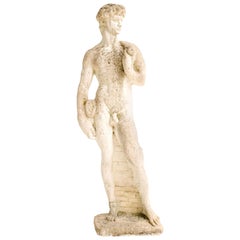Concrete David Statue
Recent Sales
Vintage 1940s Statues
Concrete
Vintage 1960s German Classical Roman Statues
Concrete
Late 20th Century Modern Statues
Concrete
Mid-20th Century Unknown Classical Roman Figurative Sculptures
Cement
Concrete David Statue For Sale on 1stDibs
How Much is a Concrete David Statue?
- 1stDibs ExpertFebruary 22, 2021The best paint to use on concrete statues is paint that contains binders that allow the coating to contract and expand along with the concrete as it warms and cools. An example of such paint is acrylic latex spray paint.
Read More
39 Incredible Swimming Pools
It's hard to resist the allure of a beautiful pool. So, go ahead and daydream about whiling away your summer in paradise.
This Lavish 18th-Century Chimneypiece Comes from a Historic Scottish Estate
The exceptionally crafted mantel was saved despite the home’s regrettable demise.
A Pair of Monumental Stone Tigers Protect and Guide Wandering Souls
The Qing dynasty beasts honored the dead and warned off malicious spirits.
Andrés Monnier’s Stone Tub Makes Bathing a Rite of Renewal
The dramatic piece transforms a daily scrub into an act of communion with the elements.
Meet the Siblings behind the Exquisite Outdoor Furniture of McKinnon and Harris
Anne and Will Massie apply the lessons of the past to create alfresco pieces as timeless as the traditions that inspire them.
35 Wondrous Outdoor Dining Spaces
Eating meals alfresco is one of the great pleasures of warm weather, and a beautifully appointed space only heightens the experience. Get inspired by these delectable dining areas as you think about creating your own outdoor oasis.
In These Chic Homes, Indoors and Outdoors Freely Mingle
Through potted plants, garden furniture, nature-inspired art and architectural apertures, designers are bringing the outside in.
24 Perfect Patios with Fire Pits and Fireplaces
In these stylish spaces, the outdoor season extends year round.

